New leadership, same mission
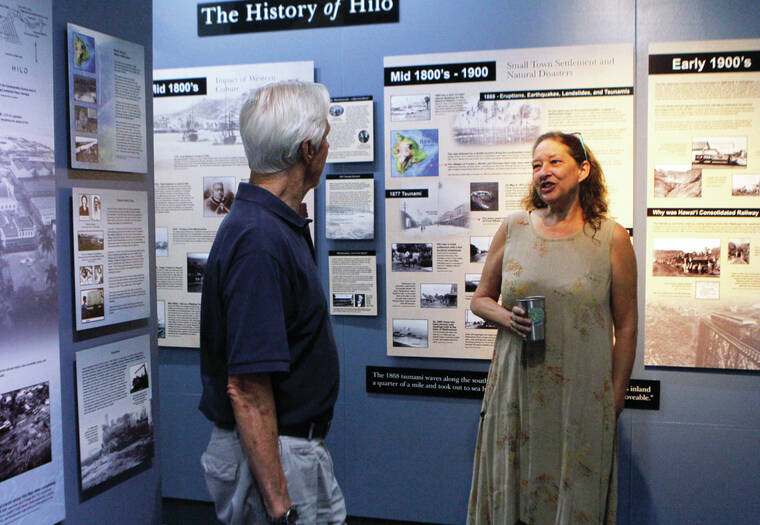
Pacific Tsunami Museum cofounder Dr. Walter Dudley and Cindi Preller, the new President and CEO, talk in the Hilo section of the museum on Tuesday, March 21, 2023. (Kelsey Walling/Tribune-Herald)
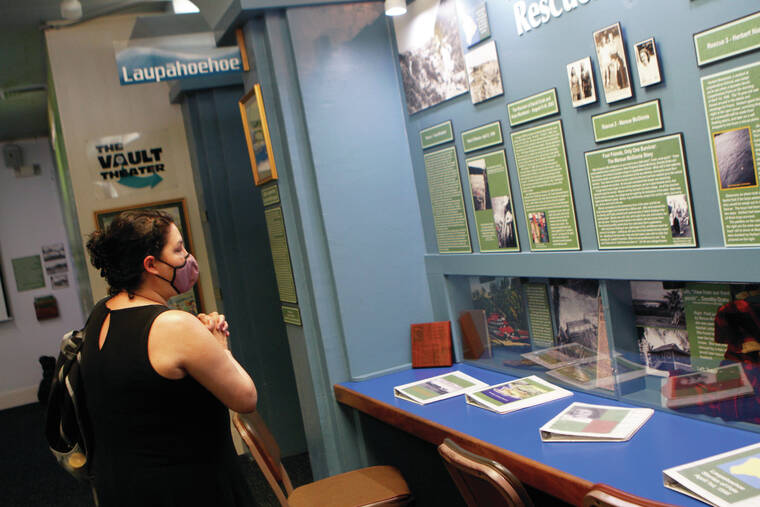
Kelsey Walling/Tribune-Herald A visitor reads about tsunami rescues at the Pacific Tsunami Museum in Hilo on Tuesday, March 21, 2023.
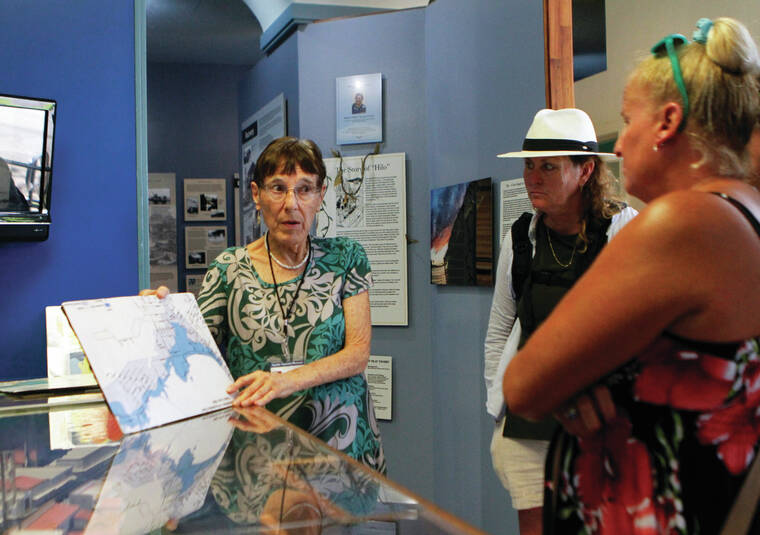
Kelsey Walling/Tribune-Herald Susan Hicks gives an overview of the tsunamis that have hit Hilo while visitors start their tour of the Pacific Tsunami Museum in Hilo on Tuesday, March 21, 2023.
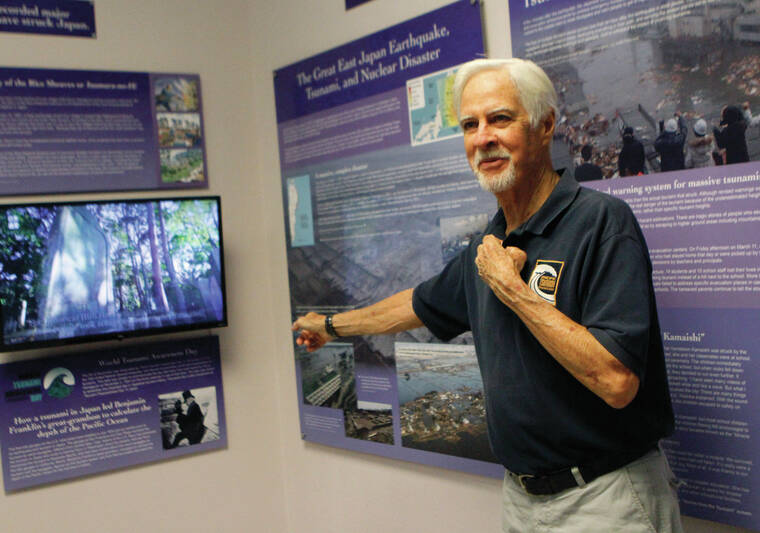
Kelsey Walling/Tribune-Herald Pacific Tsunami Museum co-founder Dr. Walter Dudley on Tuesday talks about the new Japan tsunami exhibit at the museum.
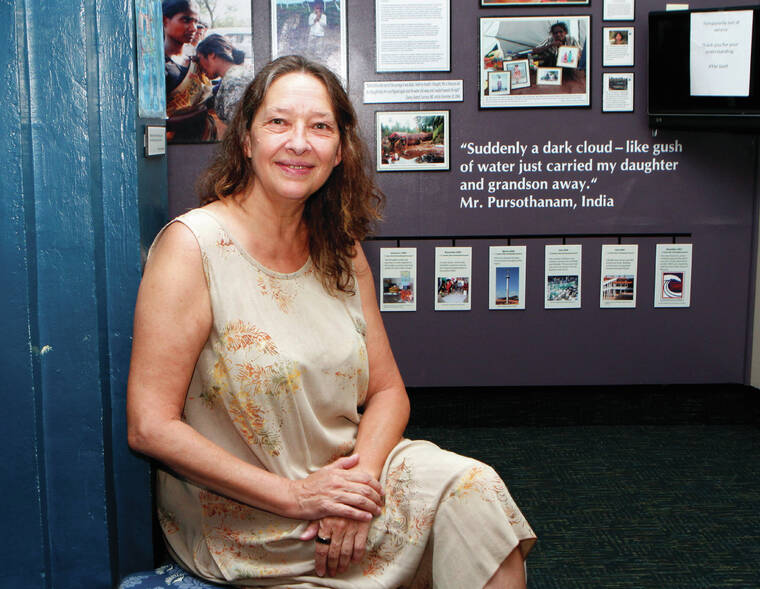
Cindi Preller on Tuesday talks about her new position as president and CEO of the Pacific Tsunami Museum. (Kelsey Walling/Tribune-Herald)
The Pacific Tsunami Museum has reopened for visitors and locals alike with a change of leadership and plans for new exhibits.
The Pacific Tsunami Museum has reopened for visitors and locals alike with a change of leadership and plans for new exhibits.
Cindi Preller is the new president and CEO of the downtown Hilo museum, which is officially open from 10 a.m. to 4 p.m. Tuesday through Saturday.
Preller has come to Hilo after spending 17 years as a senior duty scientist at the National Tsunami Warning Center in Palmer, Alaska, and the Pacific Tsunami Warning Center on Oahu.
Originally a geologist with the U.S. Geological Survey, Preller decided to join other scientists in the growing field of tsunami research after the devastating 2004 Indian Ocean earthquake and tsunami.
“2004 happened, and that injected the word ‘tsunami’ into the global vocabulary. It had been 40 years since the last devastating tsunami, so many people had forgotten about them,” Preller said. “Since the loss the life, the damage, shock and horror were so huge worldwide, the U.S. system expanded. The warning centers went from six guys each to 15 for each center.”
Preller was the first woman to work at the Alaska and Oahu tsunami warning centers and found herself on duty for every tsunami that hit land during her tenure.
Scientists with multiple backgrounds work together to study the tsunamis, since there isn’t a specific major or field of study for the phenomenon.
“Tsunamis are still a brand new science. It’s cutting-edge. Tsunamis are geophysical events that involve earthquakes and are affected by how the ocean floor responds to the geology,” Preller said. “Every tsunami is different, and every tsunami surprises us. We need tsunamis to study them, but they don’t happen that often.”
While working in Alaska, Preller met the Pacific Tsunami Museum co-founders Dr. Walter Dudley and Jeanne Branch Johnston while they were conducting survivor interviews for the Alaska tsunamis of 1958 and 1964.
“It was life-changing listening to these stories. Some people had not told their story their whole lives,” Preller said. “I feel like those interviews and survivor stories are the heart and soul of the museum. I don’t believe Hilo town would be Hilo town without survivors. Through stories, we can teach people how to survive a tsunami.”
The Pacific Tsunami Museum is dedicated to explaining the phenomenon of tsunamis while also sharing stories of survivors to help locals and visitors realize what they need to do to survive one.
Teaching safety is one of priorities of the museum, especially since tsunamis can happen so quickly.
“Our mission extends past Hilo. Tsunamis hit every shore in the world,” Preller said. “We have many school groups that come in and, to me, the keiki are the most important audience. We’re also working on putting more teacher resources on our website for kids to learn outside the museum as well.”
Preller and Dudley are planning to change the museum’s Indian Ocean exhibit with the addition of the South Pacific tsunami of 2009, where Dudley conducted 50 survivor interviews after the event.
“The tsunami in 2009 affected several Polynesian populations and was devastating. The survivor interviews are powerful,” Dudley said. “Kids were running and ringing bells to get people to evacuate.”
The museum also will be adding an exhibit about the tsunami in Tonga after the explosive eruption of the Hunga Tonga-Hunga Ha‘apai volcano in 2022.
Preller and Dudley hope to eventually create a “keiki corner” where kids will be able to use interactive activities to learn about tsunamis, including the 3-mile-high tsunami that helped wipe out the dinosaurs.
Preller is currently planning to commemorate the 1946 tsunami that hit Hilo on April 1, 1946, by offering free admission for kama‘aina.
April also is Tsunami Awareness Month, so the museum is planning events such as history lessons with Dudley and sessions in which emergency planning experts will help people create a plan for a tsunami.
There will be free admission for all first responders and their families on Saturdays in April, and the museum will be open on Sundays during the Merrie Monarch Festival, which starts April 9.
“I’m exploring the idea of offering memberships for all kama‘aina keiki, but I’ll need a grant to pull that off,” Preller said. “We want to expand our ohana and tell the stories of many of these keiki’s grandparents. A lot of survivors are getting up in age, so we want to preserve those stories for the next generation.”
During the change of leadership, the museum closed to allow time to hire people into new positions and prepare for a busy summer.
“We are so lucky to have such dedicated, passionate folks here, and we hope to draw in more of that,” Preller said. “I really want to engage with the community as much as we can.”
The museum is looking for more volunteer docents to help guide visitors through the museum.
Those interested in learning about volunteer opportunities, upcoming events, or about the museum itself can call (808) 935-0926 or visit tsunami.org.
Email Kelsey Walling at kwalling@hawaiitribune-herald.com.


